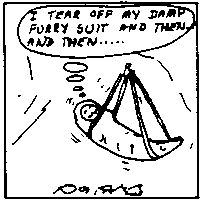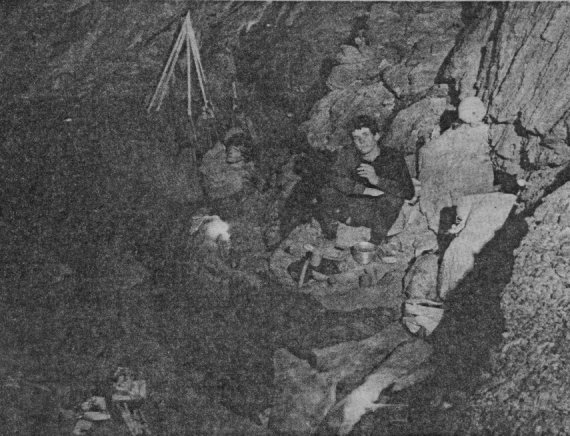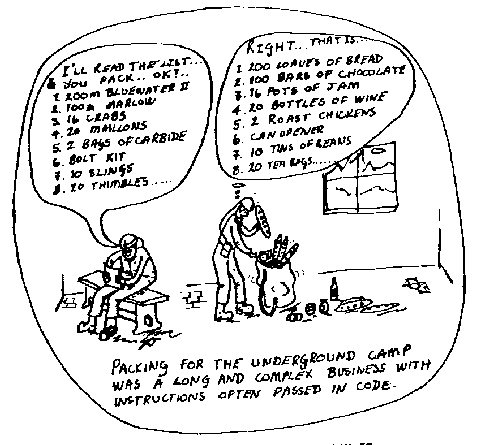


Oxford University Cave ClubProceedings 10 : "Pozu del Xitu" |
OUCC Proc 10 Contents |
 |
 |
 |
But, as we all know, these chambers either don't exist, or are in a very unsuitable place - an entrance chamber is no use (except maybe in Mulu).
A water supply close by is essential - it would be a real pain to have to crawl several hundred metres just to fill a pan for a brew, especially as the fewer pans, etc. needed the easier it is to get the camping equipment down (a major problem in itself). You'd spill most on the way back anyway.
Finding a draught free place is very worthwhile so that you don't freeze whilst cooking the meals and so that candles burn longer and give a better light.
As long as there is a reasonably dry area it doesn't matter too much whether the floor is smooth or not. The main problem with a boulder floor is that it's painful trying to walk around without boots, and things tend to get lost very easily. The floor should be very stable so that precariously balanced pans stay on top of their stoves. In most situations it should be possible to arrange boulders to provide an area for cooking and storing things (food etc.).
A sloping roof of decent rock is handy so bolts can be knocked in to support hammocks. Otherwise it is best to arrange things to give a flat space for sleeping.
Somewhere accessible but not too close has to be found, off the main route, for replying to the calls of nature. If a blind pot cannot be found then other arrangements must be made - take plenty of plastic bags down and find a safe place where they can be filled and then left. It is extremely important not to get any human excrement into the stream as it will poison it for the poor Spaniards using it for a water supply on the surface.
If the camp is flat and dry it is easiest just to sleep on the ground, on a plastic sheet (the bag providing the padding) or a karrimat which is warmer but bulkier for lugging down to the camp. In a boulder floored chamber either arrange boulders to provide a suitably spaced space for sleeping, or use hammocks. These require a sloping wall or low ceiling (so that bolts can be put in to hang them from). Hammocks with a single point suspension save time setting the camp up (only one bolt!), but whatever type they should be positioned so that they are about half a metre off the floor to facilitate getting in and out. Don't let them touch the floor though, as they are fragile and may get torn. If a bolt can only be placed high up, a cow's tail will be needed to bring the hammock within easy reach. Everyone should practise getting into a hammock when inside a sleeping bag above ground - it's not easy, and provides a lot of laughs for spectators.
Several people found the hammocks rather constricting as one can only lie flat out, and tends to have one's shoulders pressed in. This would be avoided if hammocks with spreader pieces were used (again, more bulk).There are a couple of options for what to wear whilst cooking etc. Some people stayed in their furries (minus oversuit) until they were about to get into their sleeping bag, when they either changed into some Damart or just slept in the pink. Others preferred to get out of their caving gear and into something dry straight away. Wearing a furry without the oversuit may help it dry out a little, although most people eventually came to the conclusion that the effect was small. Wearing Damart is probably preferable as it will reduce the tendency to contract jock-rot. Footwear can be a problem - keeping the same socks and boots on can lead to cold feet. I took a pair of thick socks down and put my caving boots back on, which kept my feet quite warm even though the socks got slightly damp. For rough bouldery floors caving boots will be better than gym shoes or wet socks, especially if the site chosen for crapping involves a walk downstream followed by a sharp, very difficult climb (ours did)! Even so Graham was quite happy wearing only a pair of socks. (I'm glad I didn't camp with Graham: Ed.).

Don't forget extra food for taking on caving trips such as chocolate and sardines.
A set of nesting billies is ideal for cooking in as it takes up little room and doesn't weigh much. Make sure that there are enough pans and stoves at the camp so that everything can be cooked at the same time, and so that each meal requires only one lot of washing up.
Small gaz stoves ('Bluets') were found to be very suitable for the cooking. The cylinders are cheap, easily available and reasonably robust - essential for the carry in. Petrol stoves and primuses are rather more delicate and in Spain paraffin seems to be unobtainable. A leaky petrol can could provide some excitement with carbide lights around.
A plastic (unbreakable) plate, bowl, mug and a set of cutlery (or at least a spoon) per person is helpful. Take some washing up liquid (biodegradeable!) and a scourer for cleaning the pans, though don't get carried away using the detergent, or else you'll end up fighting through great heaps of bubbles at wet pitches further down!
Cleanliness is important - if there is any doubt about the water stero-tabs should be used to purify it. In this case it would be advisable to have a large collapsible container for the water supply, as the tablets have to be left in for some while before the water can be consumed.
Carbide is best carried down in a strong waterproof container. Plastic jars big enough for 15-20 man-trips are easily obtainable in Spain although two smaller containers spread the load better. They can also be used for carrying the spent carbide out again.
Lighting at the camp is best provided by candles as they are easier to carry in than carbide. How long they last depends a lot on how draughty the camp is. Carbides can be left to burn out providing extra light (beware of sooted up jets though). Use a helmet light when traipsing off for a crap - it leaves both hands free. Lamp spares should be left at the camp, along with a torch.
A first-aid kit, including anti-diarrhoea pills, pain killers, bandages and antiseptic cream is necessary, as well as a mending kit for shredded oversuits, and spare pairs of gloves (assuming the type of caving demands gloves, as Xitu most definitely did!).
An alarm clock of sorts must be taken down, to prevent anyone from sleeping for 24 hours and thereby getting out of doing any surveying.
Don't try to save it up, or take stop pills as you'll only get caught short in a very inconvenient place without any bog roll - like on a ledge between two wet pitches. Try and go in the 'morning' or 'evening' at the camp - this happens quite naturally anyway once you're used to camping. (Ed's note: one of the contributors has scribbled "make sure that you have lots of spare pairs of gloves" at this point in the original.) Once again, it is absolutely essential that no crap gets into the stream if people are to be able to use the water below the camp.
a) the place from which water is taken to drink should be furthest upstream.
Better still, use an aven or inlet.
b) Next furthest upstream should be the washing up place.
c) Just downstream from that should be the place where you wash your
hands first. You can wash them again at b) if you feel like it.
d) Furthest downstream should be the place where you pee. This is OK
to do in the stream but once again you must never get human excrement
in the stream. Bury it unobtrusively in sealed bags well out of the way.
If you want to wash gear or lamps out in the stream do it between c) and d).
